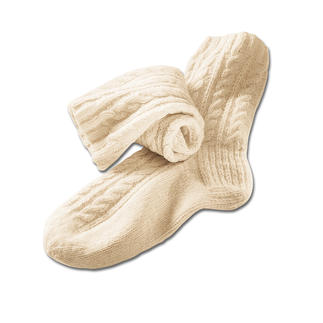 "In 1589, William Lee, a clergyman invented the first knitting machine in England. After this invention, in the 17th and 18th centuries the art of knitting was gradually taken over by guild organised cottage industry. Interestingly, the basic technology of the modern day knitting machines is similar to Lee's machine. Even the full-fashioned machine invented in 1864 by William Cotton of Leicestershire, England used the same bearded-spring needle, which was part of the original model of Lee.
"In 1589, William Lee, a clergyman invented the first knitting machine in England. After this invention, in the 17th and 18th centuries the art of knitting was gradually taken over by guild organised cottage industry. Interestingly, the basic technology of the modern day knitting machines is similar to Lee's machine. Even the full-fashioned machine invented in 1864 by William Cotton of Leicestershire, England used the same bearded-spring needle, which was part of the original model of Lee.In the 19th century power was applied to the knitting machines and simultaneously circular-knitting machines appeared on the scene. Women's stocking when knitted on original machines were a straight knitted tube, because stitches could not be added or dropped on circular knitting machine. So these products were known as hosiery. The word hosiery is derived from the old English hose, which means a covering for the leg. Now seamless stockings are knitted even on circular machines, developed in the mid-19th century. To start with cotton, wool, silk and later rayon yarns were used for making hosiery, but with the emergence of nylon in the 1940s women preferred nylon hose, because they could be permanently formed into the desired shape by heating. The use of nylon also improved the fit of hosiery due to stretchability of nylon fabrics.
Subsequently, in Great Britain, hosiery came to be associated with all types of machine-knit garments, now called knitwear. In United States they still call stockings, socks, panty hose, and tights as hosiery products. Between 1880 to 1910 knitwear was mainly a female fashion, later knitted pullovers, cardigans, skirts, men's underwear, sportswear and swimwear became popular. Developments in the 20th century increased the production speeds of the machines and offered wider choice to pattern the knitted fabrics. Now computer controlled knitting machines have come on the scene, which are highly v ersatile. Knitted garments have now become every day dress".
Even Zara has cardigans trying to look like hand-knitted every winter
Siempre han sido las mujeres las que mejor conocieron el arte de tejer. Al principio solo se hac�an calcetines y medias, pero ahora pueden conseguirse todo tipo de prendas de punto, jers�is, chaquetas, blusas e incluso faldas.
 "En 1589, William Lee, un cl�rigo, invent� la primera m�quina de tejer en Inglaterra. Tras esta invenci�n, en los siglos XVII y XVIII los gremios organizados fueron tomando el poder de este arte. Hoy en d�a a�n la tecnolog�a b�sica de estas m�quinas es similar a la de aquellas que cre� Lee hace casi quinientos a�os. Incluso en la m�quina tan moderna creado en 1864 por William Cotton de Leicesthershire se usaba la misma aguja que ya era parte del modelo original de Lee.
"En 1589, William Lee, un cl�rigo, invent� la primera m�quina de tejer en Inglaterra. Tras esta invenci�n, en los siglos XVII y XVIII los gremios organizados fueron tomando el poder de este arte. Hoy en d�a a�n la tecnolog�a b�sica de estas m�quinas es similar a la de aquellas que cre� Lee hace casi quinientos a�os. Incluso en la m�quina tan moderna creado en 1864 por William Cotton de Leicesthershire se usaba la misma aguja que ya era parte del modelo original de Lee.En el siglo XIX m�s potencia fue aplicada a las m�quinas de tejer, y de manera simult�nea, las m�quinas de tejer circulares aparecieron en la escena. Cuando las medias de se�ora eran tejidas en m�quinas originales ten�an la forma de un tubo recto, porque las puntadas no pod�an ser a�adidas en la m�quina circular. As� que estos productos comenzaron a conocerse por calceter�a. La palabra "hosiery" deriva de las antiguas mallas inglesas. Ahora los calcetines sin costuras pueden ser realizados incluso en las m�quinas circulares creadas en el siglo XIX. Para comenzar se usaba algod�n, lana, seda y m�s tarde se usar�a hilo de ray�n. El nylon apareci� en los a�os '40 del pasado siglo, y pronto se convirti� en el favorito de las mujeres, ya que su forma se pod�a adaptar a la forma deseada gracias al calor. El uso del nylon tambi�n mejoro la calidad de la calceter�a debido a la capacidad de adaptaci�n de los tejidos compuestos de nylon.
Por lo tanto, en Gran Breta�a, la calceter�a qued� asociada para siempre a las prendas tejidas a m�quina. Entre los a�os 1880 y 1910 las prendas tejidas eran b�sicamente utilizadas por las mujeres, pero m�s tarde, los jers�is tejidos a mano, cardigans, faldas, ropa interior de hombre, ropa deportiva y ropa adaptada a la nataci�n se volvieron muy populares. Las mejoras llevadas a cabo en el siglo XX incrementaron las velocidades de producci�n de las m�quinas, as� como las posibilidades de elegir c�mo tejer los materiales. Ahora las m�quinas de tejer controladas por ordenador han aparecido en escena, y son altamente vers�tiles. Las prendas de punto se han colado definitivamente en el armario de a diario."
*The translation to Spanish was made by me, so if you see mistakes, please, reported them. Thanks






No comments:
Post a Comment